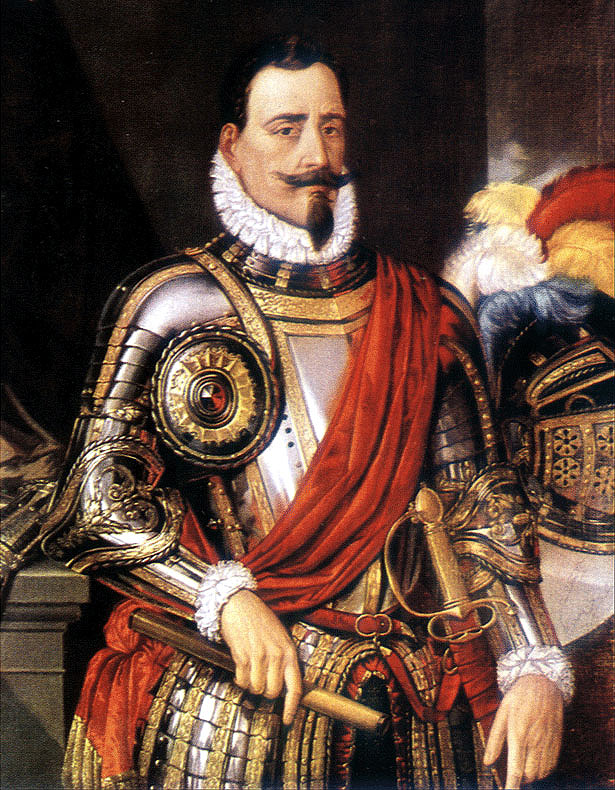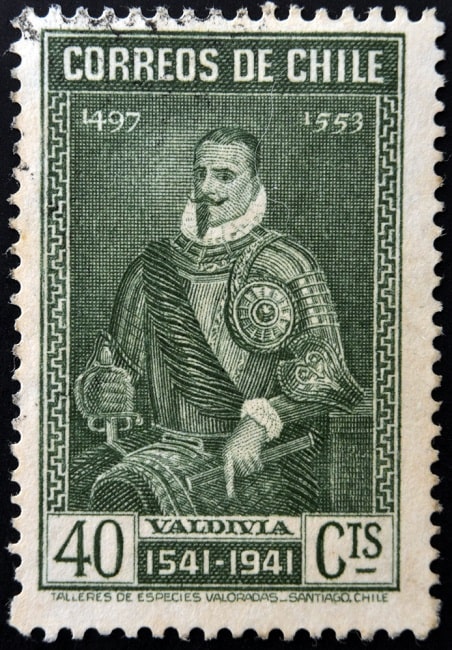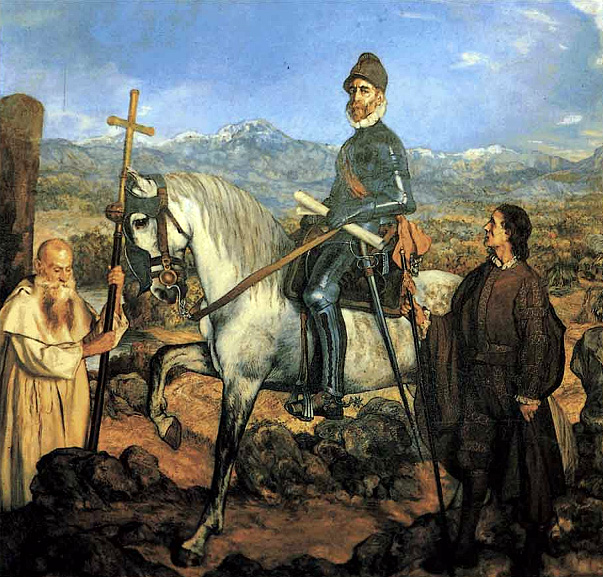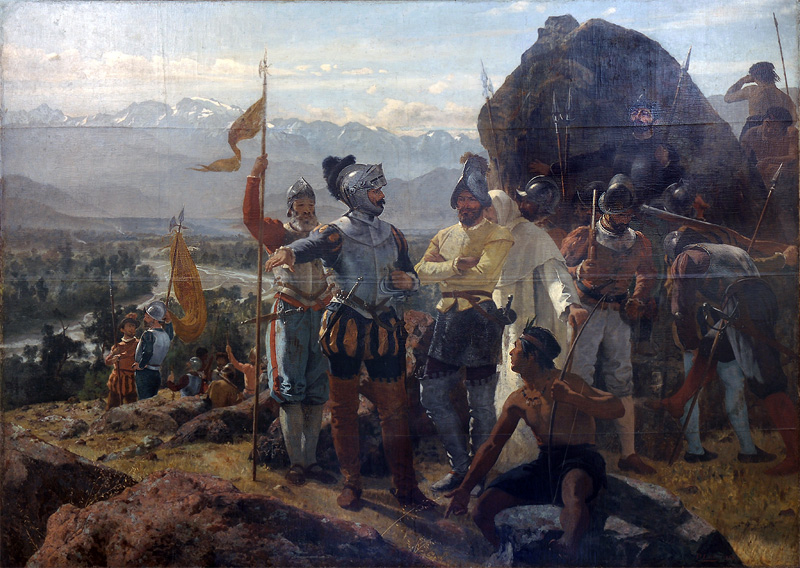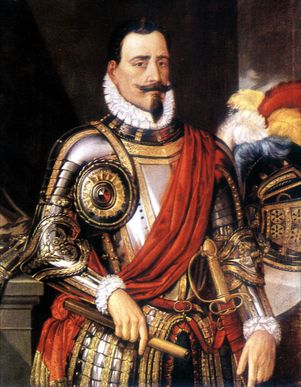
Biography of Pedro de Valdivia
Summary
Pedro de Valdivia was a Spanish military officer, conqueror and politician of Extremaduran origin, specifically from Castuera (La Serena district, Badajoz, Extremadura) born in 1500.
At a very young age he enlisted and took part in the Italian wars in Europe between the Spanish Empire and the France of Francis I. In fact, Valdivia fought in the Battle of Pavia in 1525 in which the French king was taken prisoner. For his good deeds he returned to Castile with the rank of captain.
In 1535 he left for the Indies, and first took part in an expedition in search of El Dorado on the Orinoco River that was a total failure and took him to Santo Domingo where he joined a reinforcement expedition requested by the conqueror of Peru, Francisco Pizarro, from Lima. There Valdivia quickly gained his trust and was appointed lieutenant governor and sent to conquer Chile after Diego de Almagro’s failure. They left Cuzco in 1540 and after a hard journey reached the Mapocho River valley where they founded Santiago del Nuevo Extremo or Nueva Extremadura in 1541. In later years they founded more cities such as La Serena, Concepción, Valdivia and La Imperial, thus confirming and securing the Spanish presence in the region.
With Pizarro’s death in 1541, he was appointed governor and captain general of Chile by a cabildo (council) created by himself, thus freeing himself from any commitments to Peru and becoming directly dependent on the King’s authority.
At first, the Chilean Indians collaborated with the Spanish presence, but after several years of tense coexistence, numerous conflicts broke out, giving rise to the so-called Arauco War between the Spanish and the Mapuche, which was to last for centuries without a clear winner.
Valdivia was executed after being captured by the Mapuches led by Lautaro in 1553 in what is known as the Battle of Tucapel, and was replaced as governor by Francisco Villagra.
Main article
Family
Pedro de Valdivia came from a noble family. He was the son of Diego de Valdivia and Isabel Gutiérrez and received a good education, reading and writing fluently and properly.
He married Marina Ortiz de Gaete after returning from the Italian wars in 1527, but once in the Indies his mistress was Inés Suárez, who took an active part in the conquest of Chile.
Europe
At a very young age he took part in the Italian wars in the Imperial army against the French, first in the defence of Valenciennes, then in the siege and capture of Milan and in the battle of Pavia in 1525, which led to the defeat of France and the capture of King Francis I. Finally, he took part in the defence of Naples and returned to Castile in 1527 with the rank of captain.
The Indies
Venezuela and Perú
In 1535 he arrived in the Indies in the region of Paria in Venezuela. He took part in an expedition in search of El Dorado on the Orinoco River commanded by the governor of Paria, Don Jerónimo de Ortal, which failed. Valdivia stayed in the city of Coro in Venezuela but shortly afterwards he can be seen in Santo Domingo, probably sent by Nicolás de Federmann, arrested for usurping his territory in northern Venezuela. On the island of Hispaniola he joined a reinforcement expedition requested by Francisco Pizarro in Peru. Valdivia arrived in Lima at the end of 1536 and placed himself under the command of Pizarro, who soon appointed him his field master for his magnificent performance in the confrontation between Pizarro and Almagro at the Battle of Las Salinas.
In 1538 he conquered the Collao in Upper Peru, where he founded San Miguel de Chuquisaca and received an encomienda with land and mines. There Valdivia asked Pizarro for permission to set out on the conquest of Chile after the failure of Diego de Almagro, which the governor granted him and added the posts of lieutenant governor and captain general. Recruiting soldiers was not easy because of the bad reputation the Chilean lands had acquired, that there were no riches and that the natives were very dangerous. This did not deter Valdivia, who opted to contact other small parties or expeditions in the area to gather them together and form a larger army.
Conquest of Chile
Finally, he teamed up with the trader Francisco Martínez to share the expenses and profits of the venture. Eleven Spaniards and dozens of Yanacona Indians left Cuzco in January 1540. They passed through Arequipa and reached Tarapacá. There they waited and several contingents of Spaniards arrived, adding about 100 more men.
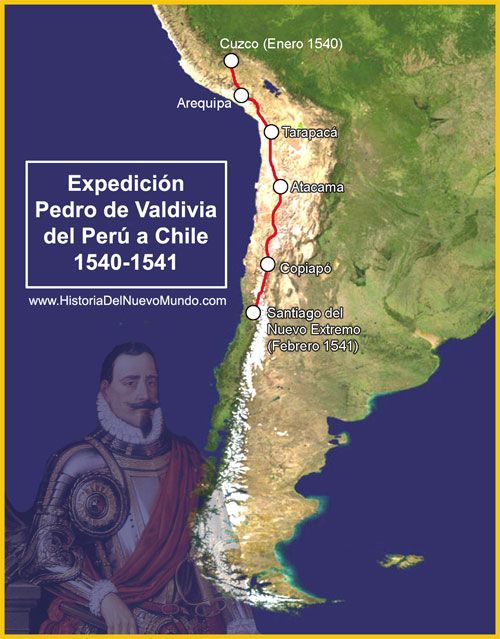
They advanced to the Copiapó valley where they took possession of the territory in the name of the King and founded the kingdom of Nueva Extremadura. From here they continued on to the Mapocho valley where they arrived in December 1540 and founded Santiago del Nuevo Extremo or Nueva Extremadura a year later, on 12 February 1541. The place had a mild climate, a riverbank and an abundant indigenous population. It was perfect for agricultural exploitation, and its proximity to the coast made it easy to supply the city. In addition, Valdivia took great care to keep the Picunche natives at peace by seeking an agreement with them to keep the region quiet.
When the news of Francisco Pizarro’s death arrived, Valdivia convened the cabildo and disengaged himself from his commitment to the governor by resigning the post assigned to him and was elected and appointed provisional governor until official confirmation from the King.
Despite the good initial atmosphere, it did not take long for tensions to arise with the natives and the first confrontation occurred on September 11, 1541, when the Mapuches attacked Santiago, completely destroying it, but even so, they were not able to expel the Spanish. They rebuilt the city and requested reinforcements from Peru, arriving in a few months 70 soldiers allowing the founding in 1544 of a new enclave that was called La Serena located north of Santiago halfway to Copiapó, thus ensuring communication with Peru. .
In the year 1544 Gonzalo Pizarro, brother of the conquistador, rose up against the Spanish crown and claimed the governorship for himself From Peru. To stop him, the king sent Lawyer Pedro de la Gasca who quickly sought support among the most important and, among them, he obtained the support of Pedro de Valdivia who contributed money, logistical support and men. He participated in the decisive battle of Xaquijaguana or Sacsahuamán on April 9, 1548 in which the rebel was defeated. As a prize, La Gasca named Valdivia governor of Nuevo Extremo and captain general and defined the limits of said governorship extending to Tierra del Fuego.
But it still had to conquer and populate the lands south of the Bío Bío River, which had little to do with the central lands in their morphology, climate and inhabitants. The rains in the central zone were more irregular, which generated a vegetation that was neither very dense nor very constant, but south of the Bío Bío the rains were more abundant and formed forests and meadows that would allow cattle raising and a more intensive agriculture. The main problem of this territory was that its inhabitants were the Mapuche people, very bellicose and with great military expertise, with whom they had already confronted in the central zone. Very soon clashes between the two began. But this did not stop Valdivia in his ambition to settle and he set about founding more cities: Concepción (1550), Valdivia (1551), La Imperial (1551), Villarrica (1552), Los Confines (1553) and military forts: Tucapel, Purén and Arauco.
At this time the confrontations with the Indians were very hard, they did not surrender easily and they adapted very well to the Spanish war strategies. In 1553, in one of these battles, Valdivia was captured in the fort of Tucapel along with 50 more men and executed by the natives.
Historical importance of Pedro de Valdivia
Pedro de Valdivia can be considered as the founder of the Chilean nation by establishing the kingdom of Nueva Extremadura as a political figure based on the structure formed by the founded cities. In spite of the difficulties, he managed that the main cities survived the Mapuche bellicosity that generated the so-called Arauco Wars that lasted practically the same time as the Spanish presence in Chile, only interrupted by the Parliaments of Quilín that demarcated different spaces of peace time with others of war.
Videos
The following videos related to don Pedro de Valdivia may be of interest to you (in spanish):
Gráficos
Below are some graphics related to don Pedro de Valdivia:
Obras
Below are downloadable works about Pedro de Valdivia and the conquest of Chile (in spanish).
- “Cartas de Pedro de Valdivia que tratan del Descubrimiento y Conquista de Chile”.
- Conferencia historiador Javier Carrasco sobre el descubrimiento y conquista de Chile.
- “Historia de Chile desde su descubrimiento hasta el año de 1575”, Alonso de Góngora Marmolejo.
- “La Araucana”, Alonso de Ercilla 1569.
Para referenciar este artículo:
Martos, David. (27-05-2023). Biography of Pedro de Valdivia. Blog Historia del Nuevo Mundo. https://www.historiadelnuevomundo.com/en/biography-of-pedro-de-valdivia/
